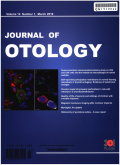- 钛学术文献服务平台 \
- 学术期刊 \
- 医药卫生期刊 \
- 五官科学期刊 \
- 中华耳科学杂志(英文版)期刊 \
Does bilateral otosclerosis make pre-operative bone conduction more inaccurate?
Does bilateral otosclerosis make pre-operative bone conduction more inaccurate?
基本信息来源于合作网站,原文需代理用户跳转至来源网站获取
摘要:
Objectives: To assess whether bilateral otosclerosis renders pre-operative bone conduction more inac-curate by increasing the Carhart effect.Methods: Retrospective review of a database of pre and post-operative audiograms of 745 ears with otosclerosis treated with stapedectomy from 2013 to 2020 in a tertiary centre. Main outcome measures: Change in bone conduction after stapedectomy for otosclerosis in: unilateral otosclerosis (U1); bilateral otosclerosis undergoing first side surgery (B1); bilateral otosclerosis under-going second side surgery (B2). The magnitude of change in bone conduction post-operatively within and between each group. Results: The average difference in pre and post-operative bone conduction was significant within in all groups (T-stat > 2 and P-value <0.05) with the greatest change observed in the U1 group. Analysis of average change in bone conduction between groups did not reach statistical significance (P-value = 0.37). Analysis of change per frequency demonstrated the greatest change in bone conduction post-operatively at 2000 Hz in all groups. The magnitude of change at 2000 Hz was the greatest in the bilateral groups;however, it did not reach statistical significance when compared to the unilateral group (P-value =0.36). Conclusions: This is the first study in the literature to assess the accuracy of pre-operative bone con-duction in bilateral versus unilateral otosclerosis. There is no evidence that pre-operative bone con-duction in bilateral otosclerosis is more inaccurate than in unilateral disease. In order to assess accuracy of pre-operative bone conduction in otosclerosis a reliable method of assessing post-operative bone conduction is required, without assumption of its equivalence to cochlear reserve.

推荐文章
一种快速Bilateral滤波器的设计与实现
Belateral滤波器
动态模板
卷积
快速傅立叶变换
快速傅立叶逆变换
《Don’t make me think》,从网页设计到产品设计
产品设计
用户体验
网页设计
Web
乙肝血清标志物阳性孕妇检测乙肝Pre-S1抗原的意义
Pre-S1抗原
乙肝标志物
酶联免疫吸附法
孕妇
内容分析
关键词云
关键词热度
相关文献总数
(/次)
(/年)
文献信息
| 篇名 | Does bilateral otosclerosis make pre-operative bone conduction more inaccurate? | ||
| 来源期刊 | 中华耳科学杂志(英文版) | 学科 | |
| 关键词 | |||
| 年,卷(期) | 2021,(1) | 所属期刊栏目 | Research Articles |
| 研究方向 | 页码范围 | 1-5 | |
| 页数 | 5页 | 分类号 | |
| 字数 | 语种 | 英文 | |
| DOI | |||
五维指标
引文网络
引文网络
二级参考文献 (0)
共引文献 (0)
参考文献 (14)
节点文献
引证文献 (0)
同被引文献 (0)
二级引证文献 (0)
1973(2)
- 参考文献(2)
- 二级参考文献(0)
1978(1)
- 参考文献(1)
- 二级参考文献(0)
1981(1)
- 参考文献(1)
- 二级参考文献(0)
1982(1)
- 参考文献(1)
- 二级参考文献(0)
1993(1)
- 参考文献(1)
- 二级参考文献(0)
1995(2)
- 参考文献(2)
- 二级参考文献(0)
2005(1)
- 参考文献(1)
- 二级参考文献(0)
2010(1)
- 参考文献(1)
- 二级参考文献(0)
2011(2)
- 参考文献(2)
- 二级参考文献(0)
2013(1)
- 参考文献(1)
- 二级参考文献(0)
2016(1)
- 参考文献(1)
- 二级参考文献(0)
2021(0)
- 参考文献(0)
- 二级参考文献(0)
- 引证文献(0)
- 二级引证文献(0)
引文网络交叉学科
相关学者/机构
期刊影响力
中华耳科学杂志(英文版)
主办单位:
解放军总医院耳鼻咽喉科研究所
出版周期:
季刊
ISSN:
1672-2930
CN:
11-4883/R
开本:
出版地:
北京市复兴路28号
邮发代号:
创刊时间:
语种:
eng
出版文献量(篇)
450
总下载数(次)
0
总被引数(次)
399
期刊文献
相关文献
推荐文献
- 期刊分类
- 期刊(年)
- 期刊(期)
- 期刊推荐

 免费查重
免费查重










